We have good news and bad news for managers.
The bad news is that, according to research, an unbelievable number of people (91%) admit that they daydream during virtual meetings.
That’s not all — brace yourself: 39% of those surveyed have dozed off during virtual meetings.
It’s time for good news — this doesn’t have to be the case.
We have a solution to this problem, and we bring it to you in the form of tips.
In this blog post, first, we’ll consider why your coworkers are not engaged during your virtual meetings.
Then, we’ll give you some tips on how to make virtual meetings more interactive and engaging. We’ll even divide our tips into categories:
- What to do before a virtual meeting,
- What to do during a virtual meeting, and
- What to do after a virtual meeting.
So, sit back, relax, and master the art of hosting engaging virtual meetings.
Table of Contents
Why people are not engaged during your virtual meetings
So, you think your virtual meetings are not as engaging as they should be to make your coworkers want to interact with you and other colleagues?
We can help.
Let’s start from the beginning.
First, we’ll establish why your meetings are not engaging and tackle the causes of this problem head-on.
Here we go!
You don’t have a clear agenda for the meeting
You think you can wing it in your meetings?
Meeting agendas are a thing of the past?
I’d hate to disappoint you, but, if you want your meetings to be more interactive and engaging, you can’t improvise.
Unfortunately, fun backgrounds and goofy memes are not enough — you need a plan.
If you don’t have an agenda, you’re risking being the only one talking, without rhyme or reason.
This is a sure-fire way to bore your coworkers and send them to the Land of Nod.
Share your meeting agenda with everyone over Pumble
You schedule unnecessary meetings
Yes, “Zoom fatigue” is real and, if you can, you should avoid excessive video meetings.
Stanford researchers, led by communication Professor Jeremy Bailenson, stress that “just because you can use video doesn’t mean you have to”.
So, how do you gauge if a meeting is necessary or not?
Before you schedule another meeting, simply ask yourself the following questions:
- Can a simple announcement replace this meeting?
- Can we discuss these matters asynchronously?
- Is a mere phone call enough?
If the answer to any of these questions is “Yes”, the meeting is unnecessary.
Scheduling too many meetings almost inevitably leads to your coworkers getting bored or annoyed with the sheer number of meetings.
If you overwhelm your colleagues this way, they probably won’t actively listen to you during the meetings. This is where that daydreaming we mentioned earlier comes in.
Could your meeting be a message? Then send a Pumble DM
You invite people who don’t need to be there
OK, so you have a clear agenda and don’t schedule back-to-back meetings, but your colleagues are still bored at your meetings.
What are you doing wrong?
Maybe the problem is you invited people who don’t necessarily need to attend the meeting in question.
If they are not essential for the discussion, you can just let them know there will be a meeting and let them choose whether they want to participate.
You don’t think the meeting through visually
If you checked all the above-mentioned points and you still catch a glimpse of an occasional yawn from your colleagues, maybe the problem is that your meetings aren’t particularly visually engaging.
Virtual meetings are more demanding than in-person ones, in terms of preparation.
Let’s take presentations as an example.
If you hold a presentation in an in-office meeting, you don’t have to go above and beyond to make your slides rich in details and understandable.
On the other hand, holding a virtual presentation requires a bit more from you in advance.
So, you should do your part and go the extra mile if needed to make your presentation more engaging to the attendees.
If you don’t make an effort to make your presentation visually appealing, your colleagues’ eyes may start to wander after a few minutes.
Now that we’ve seen why your colleagues might find your virtual meetings boring, it’s time to show you the ways to make them more interactive and engaging.
Tips for making virtual meetings more interactive and engaging
Gone are the days of monotonous meetings in which a boss delivers a speech, and all the attendees make notes in silence. At the end of the meeting, a few minutes would be left for asking questions and that would be it.
Whether virtual or in-office, meetings are now more interactive and engaging.
Or at least they should be.
But, what if they’re not?
As usual, we have got your back.
We’ve prepared several tips for you, divided into three categories:
- What to do before a virtual meeting,
- What to do during a virtual meeting, and
- What to do after a virtual meeting.
So, let’s make our way through to an amazing virtual meeting.
1. Tips for what to do before a virtual meeting
Thorough preparations might be the most important step toward a more engaging virtual meeting.
Here are some tips and tricks that will help you get your colleagues to participate in virtual meetings.
Build a great online meeting tool stack
If you want to build a shelf, you need two-by-fours, nails, and a hammer. Simply putting pieces of wood onto one another is not enough — you need tools.
Similarly, to organize a virtual meeting, you also need tools, albeit of a different kind — communication tools.
That is why the first step toward planning an online meeting is choosing communication tools that suit your team’s needs.
For instance, Pumble offers you voice and video conferencing options and allows you to share your screen.

Run engaging meetings on Pumble
Prepare a shared space in virtual surroundings
In-office meetings involve sharing a space with the meeting attendees.
On the other hand, holding virtual meetings doesn’t mean you don’t share a space with your coworkers. The difference is that this shared space is virtual.
Furthermore, shared space in virtual surroundings implies that you might share your screen, information, files, and links with your coworkers.
The best thing you can do before a meeting is to prepare all the files and documents you need to share, so you don’t waste any time searching for them when the meeting starts.
💡 Pumble Pro Tip
If you struggle with sharing information with your remote team, we have an article that will solve your problems. Check out our blog post on sharing information effectively in a remote setting:
Plan the agenda with engagement in mind and share it with participants
If you don’t want to lose your focus (and your colleagues’ attention) in aimless chatter, make sure you decide beforehand on the virtual meeting objectives.
Plan the agenda and structure the topics within the time you set aside for the meeting.
Furthermore, to avoid passive participation of your colleagues, share the agenda ahead of the meeting
This way, your coworkers will have time to prepare for the meeting and give you their full attention when the time comes.
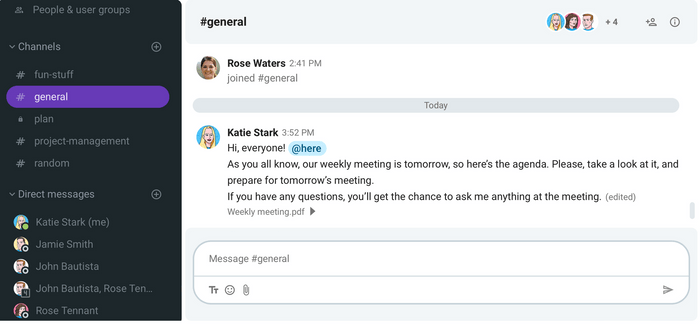
Share and store documents and files on Pumble
One of the experts we contacted while doing the research for this blog post was James Evans, Director and Lead Public Speaking Coach at Vensa Coaching.
He also recognized the problem of passive attendance:

“Unfortunately, people sometimes see attendance in a virtual meeting as something quite passive. They may treat the meeting like having the TV/radio on in the background whilst they deal with their emails. We want to make sure they’re giving the meeting their full attention and constantly participating.”
If you plan your virtual meeting agenda with engagement in mind, you’ll improve the chances your colleagues will interact with you and actively listen to you.
Invite the right people
Always make sure you have an item on your agenda for every attendee. That is the best way to check if everyone you invited needs to be in the meeting.
If you’re not sure, check with your coworkers if they’re interested in participating, like in the example from Pumble below.
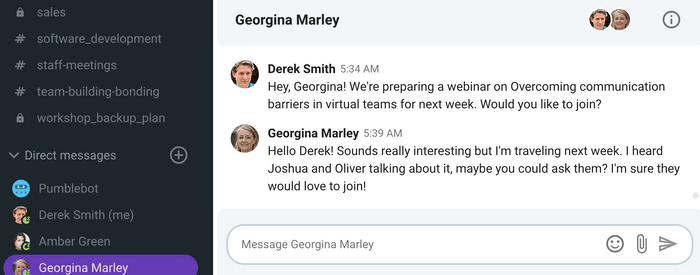
In the example above, Derek Smith is preparing for the webinar and checking with Georgina Marley if she’s interested in joining the preparatory virtual meeting for the upcoming webinar.
Since she won’t be attending the webinar, she suggests that he invites their colleagues who would love to attend, Joshua and Oliver.
This way, Derek makes sure that only the right people join in — he won’t include Georgina in the preparatory meeting for the webinar, and she won’t be bored or disengaged.
Define the rules (give each participant a time slot)
After you invite the right people to your virtual meeting, the next thing you need to do is define the rules of the meeting.
Define how much time each participant is allowed to take up and share the information with your team.
This way, you’re preventing anyone from dominating the meeting.
Aside from that, you’re giving each participant an equal opportunity to voice their opinions, thereby minimizing the possibility they will get bored.
Have a plan B
No matter how prepared you are, there’s always the possibility that something will go wrong.
Maybe your key participant is ill and cannot attend the meeting.
Or, a report you’ve been waiting for hasn’t arrived before the meeting started.
Whatever happens, make sure you’re prepared for the worst-case scenario.
The solution is simple — have a plan B.
For example, if your keynote speaker is ill, ask them politely to send you their presentation, so you can deliver their presentation to other attendees.
That way, you’ll always land on your feet, whatever unforeseen circumstances come up your way.
—
Now, we can safely say that you’re well-prepared for your virtual meeting. You did your best to ensure no one is disengaged and bored.
It’s time to make your virtual meeting memorable.
It’s an easy feat with the tips we bring to you in the following paragraphs.
2. Tips for what to do during a virtual meeting
So, you did your homework and prepared for the virtual meeting. You’re sure nothing can go wrong.
Are you really?
Let’s make double sure your coworkers won’t be yawning during your virtual meeting.
Here are some tips for you!
Dedicate time to checking in
The meeting has started.
No matter how long you and your colleagues have known one another, there’s always that awkwardness at the beginning of a virtual meeting.
So, what can you do to make the tension go away?
Start by checking in with your coworkers.
Although you’re not physically in the same space, make them feel present.
Dedicate some time to chewing the fat. Ask your colleagues about their day up to that point and connect with them.
Small talk is sometimes underrated — its impact is much greater than you think.
Namely, according to a study by Rutgers and the University of Exeter Business School, chit-chat at work has an uplifting effect on employees.
Small talk is especially important in a remote setting, where casual bonding by the water cooler is not possible.
💡 Pumble Pro Tip
Now that you know exchanging pleasantries has its benefits at the workplace, maybe you need help deciding on the right amount of casual communication at work. If that’s the case, read our article on balancing work communication and chit-chat:
Use meeting icebreakers and games
If small talk doesn’t come naturally to you, we might just have a solution for your problem.
Why not take a more structured approach to chit-chat?
Yes, we’re talking about icebreakers and games.
Set aside some time at the beginning of the meeting for tuning in and having fun with some games.
Some ice-breaker questions you could ask are:
- If you could only eat one food for the rest of your life, what would it be?
- If you were an animal, what would you be?
- If you could have dinner with anyone in history, dead or alive, who would it be?
These kinds of questions help your colleagues loosen up.
They also set the tone for the meeting and make the overall experience more fun.
Instead of yawns, there’ll probably be a few laughs.
💡 Pumble Pro Tip
If team bonding is your thing, but you lack ideas for virtual activities, read our article on virtual team bonding activities:
Keep to the meeting agenda
Think of the meeting as a symphony your orchestra (your colleagues) is performing.
As the conductor, you must keep everything under control, direct the musicians, and make sure they follow the right tempo.
Similarly, as a meeting leader, you need to keep to the meeting agenda. At the end of the day, that’s why you planned it — to give your meetings some structure.
We reached out to Rebecca Churchill, Small Business Legislative Advocate at National Small Business Association, who shared her opinion with us:

“Those who lead the meeting need to keep to an agenda and make sure it is bringing value and having decisions made and actionables assigned. Virtual environments require managers to do a lot more work — in terms of engagement and one-on-one connecting.”
So, take the baton in your hands, and conduct your orchestra toward the goal, by following your agenda.
Delegate tasks and responsibilities
This is a somewhat overlooked step toward a more interactive and engaging virtual meeting.
Since you’re not alone in a meeting, you don’t have to do everything by yourself.
Namely, you can delegate tasks and assign roles to your coworkers.
Ideally, every meeting should have:
- The leader — a person who develops agenda and assigns other meeting roles
- The recorder — a person responsible for taking notes
- The timekeeper — a person whose job is to manage time limits
- The participant(s) — all the other attendees whose responsibility is to understand the agenda and the purpose of the meeting, as well as to contribute to the discussion
When all the meeting attendees are somehow involved in the process, they are more motivated to make a contribution and ensure that the meeting is successful.
Be mindful of remote meeting etiquette
The eye of the camera sees everything, and microphones are getting ever more sensitive to every little noise.
That’s why it’s important to tidy up your workspace and avoid snacking or chewing gum while in the meeting.
It’s common courtesy to mute your microphone if you’re not speaking so that you don’t distract your teammates with the noises coming from your surroundings.
The fact that you’re not in the same physical space as your coworkers doesn’t mean you should forget about the meeting etiquette or body language.
That’s why Erica Dhawan, the author of Digital Body Language, gave us 5 principles of digital communication that we should be aware of:
- Brevity creates confusion — Don’t rush just for the sake of being brief.
- “Communicate your mind” mindset — People can’t read our minds, especially when we’re behind the screen. So, speak freely about what’s on your mind.
- Hold your horses — Take your time to process information, then share your thoughts.
- Assume the best intent — If in doubt whether someone is being rude, always assume they have the best intentions. Maybe they are just a bit clumsy in the digital world.
- Find your voice — Are you an extrovert or introvert? Is there a generation gap among your coworkers? Be mindful of all the differences and speak your mind according to your values and voice.
💡 Pumble Pro Tip
Your colleagues come from different generations, and you’re not sure how to communicate with them? Check out our article on improving communication across generations at work:
Add gamification elements
The best way to introduce some fun into your virtual meeting is to add some gamification elements.
Surprise your coworkers and incorporate short fun activities now and then.
According to research, gamification can enhance your coworkers’ virtual meeting experience and provide you with long-term engagement from them.
We’ve contacted Megan Bendtzen, Consultant, Speaker, and Fun Specialist at TheDoctorofFun.com.
She strongly agrees with the gamification method:

“Incorporate games! Gamification increases engagement! Turn your talking points into questions, insert fun trivia or turn attendees into contestants and run the meeting game-show style.”
There’s no better way to engage your audience than to enable them to participate in a fun activity.
Feature visual and interactive elements
Do you think visual elements are overrated?
What if I told you that visuals increase engagement by as much as 94%?
According to Techsmith’s research, more than 64% of Millennials understand information faster when it’s communicated visually.
And, if we remember that the number of Millennials now exceeds the number of Boomers in the workforce, this information becomes even more relevant.
So, when hosting a virtual meeting, always add interactive and engaging visual elements.
Don’t refrain from incorporating a video into your virtual meeting to keep your coworkers engaged.
Another useful trick is to use live polls during your virtual meetings because they’re a fun way to gauge people’s reactions and thoughts on any matter.
Increase engagement with a theme
Why not take it up a notch and come up with a theme for the virtual meeting?
You can start with something simple, such as wearing the company logo.
If you feel especially creative, you can host a virtual meeting with a fun “Sci-Fi vibe” or “Wear your favorite band T-shirt” theme.
A little goes a long way. Why not try it?
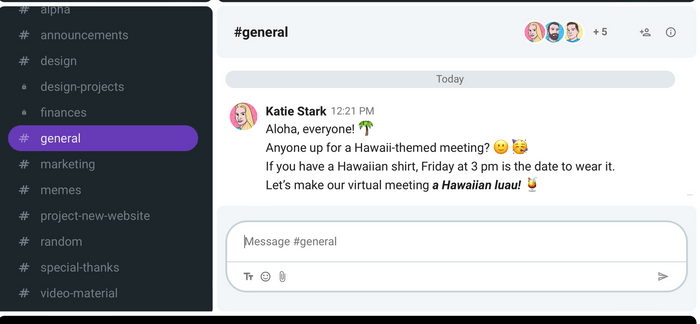
Explore Pumble’s Video Conferencing features
In the example above, we see an announcement that Katie Stark, a team manager, makes to her team for an upcoming virtual meeting.
Surely, they won’t hawaii any trouble with breaking the ice.
Keep it short and to the point
What’s the sweet spot when it comes to the duration of virtual meetings?
Some research suggests that 83% of office employees cannot stay focused in meetings for over 45 minutes.
So, your meetings should be short and to the point.
If you follow our advice on what to do before a virtual meeting, you shouldn’t have any trouble keeping your meetings shorter than 45 minutes.
This way, the attendees can stay fully focused and engaged.
Now that we have prepared you for virtual meetings, it’s time to give you some tips on what to do after the meeting.
3. Tips for what to do after the meeting
So, you’ve finished your virtual meeting. Your coworkers were interested in what was being said, and they even participated in the discussion.
Your work here is done, right?
Wrong!
To keep your colleagues engaged and inspired, you need to do your part after a virtual meeting as well.
That’s why we bring you a few more tips to help you wrap up the virtual meeting experience.
Quickly send out the meeting notes
Don’t be afraid to overcommunicate to increase the effectiveness of the meeting.
As soon as your virtual meeting ends, make sure you send your coworkers the meeting notes, reminding them of the main points you discussed.
Check with your colleagues whether the plan you discussed is clear and answer any follow-up questions they might have forgotten to ask during the meeting.
You can also record and transcribe virtual meetings.
Then, you can send the recording or transcript to your colleagues who couldn’t attend the meeting, to keep everyone in the loop.
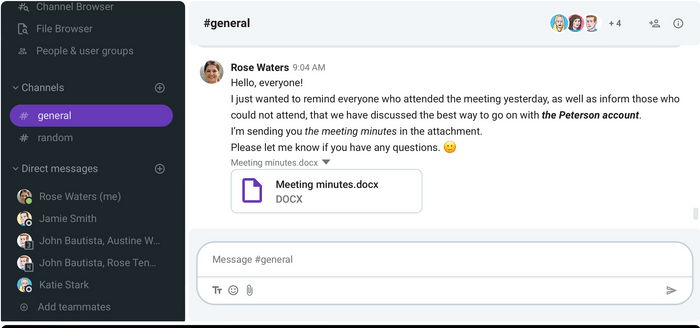
Keep everyone in the loop with Pumble
In the example above, Rose Waters, VP of Sales, reminds those who were in the meeting and informs those who weren’t of the main points discussed.
Follow up on the commitments made
After you delegate tasks to your coworkers, don’t forget to follow up — check if everyone’s doing their part.
Be persistent because no matter how talented and hard-working your coworkers are, sometimes, they don’t follow through for various reasons.
Maybe they’re overwhelmed with other tasks, so they simply forget to do what they agreed to do.
So, if you want a task to be done, make sure you regularly check in with your coworkers.
But beware — you don’t want your check-ins to turn into micromanaging.
Still, follow-ups are a necessary part of heading a project, as we can see in the example below.
In the virtual meeting, manager Katie tasked Rose with writing a report on a new client.
Now, she is checking in with Rose to see if she has any trouble with the report.
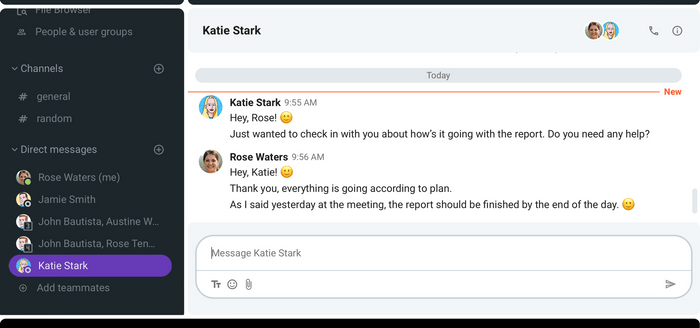
Make your virtual meetings engaging with Pumble
Virtual meetings should not be associated with yawning and counting seconds to the end of the meeting.
The key to making virtual meetings more interactive and engaging is in your hands.
If you follow our tips, then all you really need is a good tool to put them into practice.
With Pumble, a team communication and collaboration app, you’ll be able to conduct interactive meetings that will keep your team members engaged.
Thanks to features like video conferencing, screen sharing, file sharing, and hand raising — to name a few — Pumble will help you become the best meeting organizer you can be!
Make the most out of your meetings — with Pumble!








